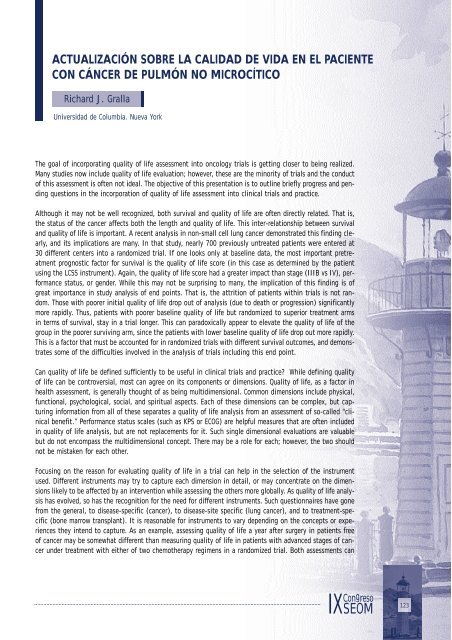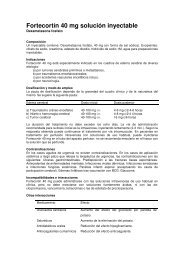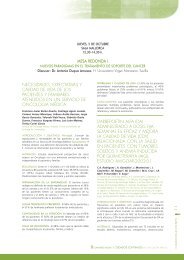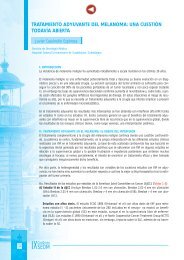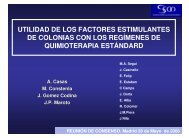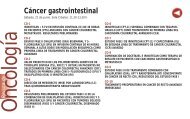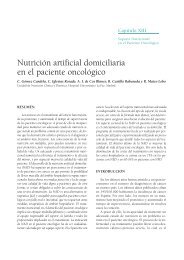Resúmenes de Ponencias - Sociedad Española de OncologÃa Médica
Resúmenes de Ponencias - Sociedad Española de OncologÃa Médica
Resúmenes de Ponencias - Sociedad Española de OncologÃa Médica
You also want an ePaper? Increase the reach of your titles
YUMPU automatically turns print PDFs into web optimized ePapers that Google loves.
ACTUALIZACIÓN SOBRE LA CALIDAD DE VIDA EN EL PACIENTE<br />
CON CÁNCER DE PULMÓN NO MICROCÍTICO<br />
Richard J. Gralla<br />
Universidad <strong>de</strong> Columbia. Nueva York<br />
The goal of incorporating quality of life assessment into oncology trials is getting closer to being realized.<br />
Many studies now inclu<strong>de</strong> quality of life evaluation; however, these are the minority of trials and the conduct<br />
of this assessment is often not i<strong>de</strong>al. The objective of this presentation is to outline briefly progress and pending<br />
questions in the incorporation of quality of life assessment into clinical trials and practice.<br />
Although it may not be well recognized, both survival and quality of life are often directly related. That is,<br />
the status of the cancer affects both the length and quality of life. This inter-relationship between survival<br />
and quality of life is important. A recent analysis in non-small cell lung cancer <strong>de</strong>monstrated this finding clearly,<br />
and its implications are many. In that study, nearly 700 previously untreated patients were entered at<br />
30 different centers into a randomized trial. If one looks only at baseline data, the most important pretreatment<br />
prognostic factor for survival is the quality of life score (in this case as <strong>de</strong>termined by the patient<br />
using the LCSS instrument). Again, the quality of life score had a greater impact than stage (IIIB vs IV), performance<br />
status, or gen<strong>de</strong>r. While this may not be surprising to many, the implication of this finding is of<br />
great importance in study analysis of end points. That is, the attrition of patients within trials is not random.<br />
Those with poorer initial quality of life drop out of analysis (due to <strong>de</strong>ath or progression) significantly<br />
more rapidly. Thus, patients with poorer baseline quality of life but randomized to superior treatment arms<br />
in terms of survival, stay in a trial longer. This can paradoxically appear to elevate the quality of life of the<br />
group in the poorer surviving arm, since the patients with lower baseline quality of life drop out more rapidly.<br />
This is a factor that must be accounted for in randomized trials with different survival outcomes, and <strong>de</strong>monstrates<br />
some of the difficulties involved in the analysis of trials including this end point.<br />
Can quality of life be <strong>de</strong>fined sufficiently to be useful in clinical trials and practice? While <strong>de</strong>fining quality<br />
of life can be controversial, most can agree on its components or dimensions. Quality of life, as a factor in<br />
health assessment, is generally thought of as being multidimensional. Common dimensions inclu<strong>de</strong> physical,<br />
functional, psychological, social, and spiritual aspects. Each of these dimensions can be complex, but capturing<br />
information from all of these separates a quality of life analysis from an assessment of so-called “clinical<br />
benefit.” Performance status scales (such as KPS or ECOG) are helpful measures that are often inclu<strong>de</strong>d<br />
in quality of life analysis, but are not replacements for it. Such single dimensional evaluations are valuable<br />
but do not encompass the multidimensional concept. There may be a role for each; however, the two should<br />
not be mistaken for each other.<br />
Focusing on the reason for evaluating quality of life in a trial can help in the selection of the instrument<br />
used. Different instruments may try to capture each dimension in <strong>de</strong>tail, or may concentrate on the dimensions<br />
likely to be affected by an intervention while assessing the others more globally. As quality of life analysis<br />
has evolved, so has the recognition for the need for different instruments. Such questionnaires have gone<br />
from the general, to disease-specific (cancer), to disease-site specific (lung cancer), and to treatment-specific<br />
(bone marrow transplant). It is reasonable for instruments to vary <strong>de</strong>pending on the concepts or experiences<br />
they intend to capture. As an example, assessing quality of life a year after surgery in patients free<br />
of cancer may be somewhat different than measuring quality of life in patients with advanced stages of cancer<br />
un<strong>de</strong>r treatment with either of two chemotherapy regimens in a randomized trial. Both assessments can<br />
Congreso<br />
IXSEOM<br />
123


